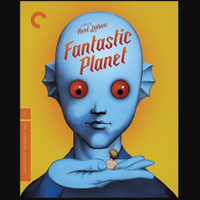
The beautifully bizarre animated classic ‘Fantastic Planet’ turns 50 today (Image Credit: Space.com)
In the immersive arena of global animation where anything is possible, director René Laloux’s counterculture gem, “Fantastic Planet” (“La Planète sauvage”), remains unrivaled in its strange and surreal fable set on the pastel-hued alien planet of Ygam.
And today on the occasion the French movie’s milestone 50th anniversary, its themes and symbolisms feel even more relevant than when it originally premiered due to its detailed worldbuilding, haunting characters and musician Alain Goraguer’s jazzy rock score that leaves an entrancing effect on adventurous souls who fall victim to its innumerable emotional charms.
This cult feature film rattled the inventive medium starting back on Dec. 1, 1973 when it was first released and has remained a touchstone of inspiration and influence for generations ever since. Its politically charged allegory of violent oppression set on a bizarre world is injected with hot topic Earth-like issues of racism, animals rights, tyranny and enslavement, all presented here for viewers’ moral meditations while being embraced in a delirious cartoon fever dream.
The Criterion Collection edition of “Fantastic Planet” is a beautifully restored version of Director René Laloux’s surreal and beautifully illustrated work of animated science fiction.
” data-widget-price=”{“currency”:”USD”,”amount”:”31.27″}” data-widget-type=”deal” data-render-type=”editorial”>

Here’s the official synopsis:
“This animated tale follows the relationship between the small human-like Oms and their much larger blue-skinned oppressors, the Draags, who rule the planet of Ygam. While the Draags have long kept Oms as illiterate pets, this hierarchy shifts after an Om boy becomes educated, thanks to a young female Draag. This leads to an Om rebellion, which weakens the Draag control over their race. Will the Oms and the Draags find a way to coexist? Or will they destroy each other?”
Laloux’s landmark project which was adapted from Stefan Wul’s 1957 novel, “Oms en série” (“Oms by the Dozen”). Stefan Wul was actually the pen name of Pierre Pairault (1922–2003), a dental surgeon who dabbled in science fiction stories while not practicing his toothy trade.
The trippy 72-minute movie was produced as a joint cinematic venture between France and Czechoslovakia and featured an adapted screenplay courtesy of Laloux and Roland Topor. Original drawings were conceived by Roland Topor, with additional character and scene animation by Josef Kábrt & Josef Vánǎ.
Science fiction has always been a kind of reflective canvas with which to stealthily examine the lesser angels of humankind’s true nature, and here in “Fantastic Planet’s” wildly imaginative realm, fans were free to explore these issues in a hostile setting completely foreign yet somehow vaguely familiar.
“Fantastic Planet” deservedly won the Special Jury Prize at the Cannes Film Festival in 1973 and is a prime example of the psychedelic era’s interesting style of cutout stop motion animation that would often be seen showcased in Monty Python’s humorous animated collages.

Upon a fresh viewing of “Fantastic Planet,” one is swept away into hallucinatory vistas of the exotic planet of Ygam. It has a trance-like, narcotic quality and viewers are lured into its Salvador Dali-like environments and phantasmagoric creatures.
Aside from being currently available to screen on the Max streaming platform, The Criterion Collection has released a hi-def Blu-ray transfer featuring a new 2K digital restoration, with a uncompressed monaural soundtrack, alternate English-language soundtrack, “Les temps morts” (1965) and “Les escargots” (1966) short films by director René Laloux and illustrator Roland Topor, “Laloux sauvage,” a 2009 documentary on Laloux, a 1973 interview with Topor, official trailers, new English subtitle translation, and an illuminating essay by critic Michael Brooke.

“Fantastic Planet” represents a high-water mark for boundary-pushing animation of the 1970s. Though some aspects of its weird wonders have trickled down into the myriad creations of filmmakers, artists, painters, sculptors, authors, and video game designers over the decades, there’s still no substitute for the surreal artistry of this original classic that first won over both critics and audiences some fifty years ago.






